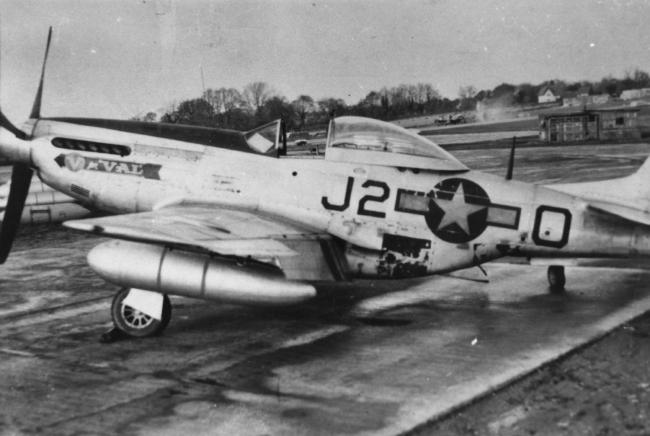Wattisham
Airfield
Roger Freeman Photo.
Object Number - FRE 564 - Major Henry Porter Plunk and a fellow airman of the 479th Fighter Group stand with Plunk's P-51 Mustang (9B-0, serial number 44-72516) nicknamed...
Built in 1938 as a medium bomber station with a grass airfield, Wattisham was occupied by the RAF until handed over to the Eighth Air Force in September 1942. The 68th Observation Group was the first American unit to occupy the station from October to December 1942, equipped with P-39s. Intended to be improved in 1943 with three concrete runways, it had eventually had one concrete, one mainly steel mat, and one mainly grass runways. There were ultimately 56 loop and 19 pan concrete hardstandings. The original four C hangars were supplemented by four T2 hangars. Expanded to become the 4th Strategic Air Depot, responsible for overhaul and repair of fighter aircraft, the Air Depot complex was built mainly in the village of Nedging Tye on the southern edge of Wattisham airfield, although was named officially Hitcham. The 479th Fighter Group shared the airfield with the Air Depot from May 1944 to November 1945, equipped initially with P-38s and then with P-51s from September 1944. Handed back to the RAF in December 1945, the station was an RAF fighter base until closed in 1992 and handed over to the British Army in 1993. Wattisham Airfield is currently the biggest centralised operational Army Airfield in the UK.
Connections
See how this entry relates to other items in the archive by exploring the connections below.
English Heritage's Record Description
A military airfield used from World War Two onwards. The airfield was built in 1938 by John Laing and Sons as part of the Royal Air Force's Pre-War expansion scheme. There was a range of permanent military buildings, including an arc of four aircraft hangars (either Type C or Type L). It opened in 1939 and was initially a Royal Air Force bomber station for 107 and 110 Squadrons. 110 Squadron carried out the first bombing raid on the German fleet at Wilhelmshaven. In 1942 the airfield was transferred to the United States Army 8th Air Force, as USAAF Station 377. The Americans began to redevelop the airfield with new hard runways for use by bombers but the priorities were changed and the work was not completed as fully planned: the airfield became an Air Depot for serving and repairing aircraft, and to this end a technical area to the south of the airfield with a taxiway and Type T2 aircraft hangars was built on the south side of the airfield. Additional accommodation for personnel in the form of Nissen huts were added. The airfield also had a fighter unit, the 479th Fighter Group, nicknamed "Riddle's Raiders". During the Cold War the airfield returned to the Royal Air Force and was altered, including the laying of a new runway in 1950. It was used for the British "V -bomber" jet force and later for a Bloodhound Missile site: for further details of the latter site please see TM 05 SW 24. In 1993 the airfield transferred to the British Army Air Corps.
People
- Military/Civilian/Mascot: Military
- Nationality: American
- Unit: 479th Fighter Group 436th Fighter Squadron
- Service Numbers: O-760455
- Highest Rank: Second Lieutenant

- Military/Civilian/Mascot: Military
- Nationality: American
- Unit: 479th Fighter Group 436th Fighter Squadron
- Highest Rank: Master Sergeant
- Role/Job: Crew Chief

- Military/Civilian/Mascot: Military
- Nationality: American
- Unit: 479th Fighter Group 434th Fighter Squadron
- Service Numbers: 19116002 at enlistment, then O-760458
- Highest Rank: Lieutenant Colonel
- Role/Job: Pilot
- Military/Civilian/Mascot: Military
- Nationality: American
- Unit: 479th Fighter Group 436th Fighter Squadron
- Highest Rank: Staff Sergeant
- Role/Job: Asst Crew Chief
- Military/Civilian/Mascot: Military
- Nationality: American
- Unit: 479th Fighter Group 435th Fighter Squadron
- Service Numbers: O-760313
- Highest Rank: Second Lieutenant
- Role/Job: Fighter Pilot
Aircraft

- Aircraft Type: P-51 Mustang
- Nicknames: Margie Peregrine Jr.
- Unit: 479th Fighter Group 434th Fighter Squadron

- Aircraft Type: P-51 Mustang
- Nicknames: Mass Kid
- Unit: 359th Fighter Group 479th Fighter Group 368th Fighter Squadron 435th Fighter Squadron

- Aircraft Type: P-51 Mustang
- Unit: 361st Fighter Group 479th Fighter Group 376th Fighter Squadron Headquarters (479th Fighter Group)

- Aircraft Type: P-51 Mustang
- Nicknames: V for Val
- Unit: 479th Fighter Group 435th Fighter Squadron

- Aircraft Type: P-51 Mustang
- Nicknames: Teddie 4 Skunk Chaser
- Unit: 479th Fighter Group 434th Fighter Squadron
Revisions
Barry Anderson, Army Air Forces Stations (Alabama, 1985) / Roger Freeman, Airfields of the Eighth Then And Now (London, 1978)
Roger Freeman, Mighty Eighth War Manual (2nd edn, London, 2001)
Michael Bowyer, Action Stations 1: Wartime
Military Airfields of East Anglia 1939-1945 (London, 1979)
http://en.wikipedia.org/wiki/RAF_Wattisham